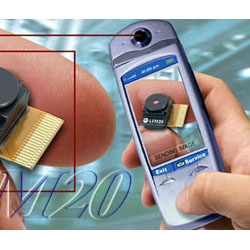
More consumers will soon be smiling at cell phones and smartphones, not cameras, thanks to an advanced camera module from Motorola's Semiconductor Products Sector.
Development time and design creativity for wireless original equipment manufacturers and original design manufacturers using Motorola's i.250 Innovative Convergence 2.5G platform are being significantly compressed by fully integrating an advanced VGA imaging module. Motorola's i.IM20 is engineered to provide high-quality imaging capabilities to the mobile phone market place with a comprehensive camera sub-assembly including camera applications software. The device features a VGA resolution image sensor, a three-element lens system and an image co-processor.
This module is developed using Motorola's advanced sub-micron ImageMOS technology. ImageMOS technology is designed to enhance color and minimize noise while achieving excellent light sensitivity across the visible spectrum. Coupled with the integrated state-of-the-art optics and Motorola's image processing technology, the i.IM20 is designed to produce high-quality, true color images for mobile imaging applications.
"By integrating imaging technology into their core 2.5G platform, Motorola is accelerating handset manufacturers time-to-market and time-to-revenue and allowing manufacturers to meet the expected growth in consumer demand for camera phones," stated IDC analyst Ron Glaz.
"Handset manufacturers can expect to add image capture capability to their designs, thereby enhancing the value of their products and giving consumers endless imaging capabilities anytime, anywhere. Image capture also allows manufacturers to personalize and differentiate their mobile phone experience," stated Pete Shinyeda, corporate vice president and general manager of Motorola's Wireless and Broadband Systems Group. "Using our i.250 Innovative Convergence platform or i.Smart smartphone reference design, Motorola reduces the design effort and time of OEMs and ODMs by taking care of the integration of complex camera modules. This allows our customers' to focus on providing design innovation."
Versatile Module Feature Set
The i.IM20 module with VGA (640 X 480 pixel) resolution, supports video frame rates at 30 frames per second, twice the requirement of today's mobile phones. Output modes include YUV (at 8- or 16-bit) in ITU-R BT-656 or Red Green Blue (RGB) formats. The versatile high performance output is designed for minimum impact on other system functions by allowing direct memory bus interface or connection to an external video processor.
The high performance memory bus interface is designed for image capture and video transfer rates of 56 mega bytes per second, four times the rate of conventional 8-bit "streaming video" transfer rates. The device's output is also designed to interface directly with today's high performance memory devices - for high-quality streaming video, high-speed image capture, and fast image storage. The low voltage at 1.8-volts interface also saves battery power and maximizes valuable talk time.
The i.IM20 image co-processor features embedded firmware designed to support Motorola automatic exposure technology, white balance, and automatic gain control. The co-processor is also designed to support programmable gamma correction, color space conversion and versatile output interfaces. The baseband host processor communication and control to the i.IM20 is selectable between I2C or SPI compatible interfaces.
A variety of functions are under host processor control and are engineered to enable the i.IM20 to easily switch between output format modes and to enable "on the fly" image resizing, with no external memory requirements. The "window-of-interest" panning and zooming and sub-sampling is engineered to be digitally controlled by the host processor. The highly flexible I/O is designed to support interface voltages from 1.8- to 3.3-volts and can be configured as a memory mapped peripheral or can connect to an external video processor in a streaming video mode. The 1.8-volt memory bus capability is a distinctive feature in the industry today designed for exceptionally high performance and low power interfaces.